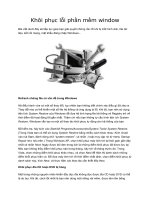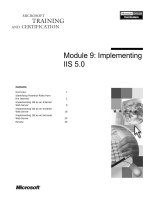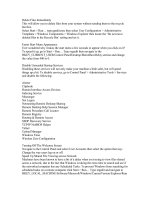Tài liệu Technicians’ Best Practices: Handling Reduced Bend doc
Bạn đang xem bản rút gọn của tài liệu. Xem và tải ngay bản đầy đủ của tài liệu tại đây (117.94 KB, 4 trang )
WHITE PAPER
Technicians’ Best Practices:
Handling Reduced Bend
Radius Fiber
Technicians’ Best Practices:
Handling Reduced Bend Radius Fiber
Some monumental breakthroughs have taken place in optical fiber cables
and their ability to bend around sharp corners without increasing attenuation
– but today’s technicians and installers may be receiving mixed messages. This
paper will highlight the potential issues surrounding these new fibers as they
apply to the people who handle and install the cables in fiber-to-the-premise
(FTTP) applications.
The possibility of perceiving these new fibers as being virtually indestructible
is a dangerous misperception. Technicians must be acutely aware that reduced
bend radius fibers are, in the end, still glass and still subject to the same forces
that have traditionally caused increased attenuation problems and failure in
optical links. ADC’s intent is to educate technicians and installers about the
true attributes of reduced bend radius fibers while reinforcing the idea that
proper fiber cable management techniques still apply.
Bend-proof isn’t break-proof
Technicians should be aware that the new breed of reduced bend radius fibers
can reduce minimum bend radius requirements significantly, but they can also
still become damaged or even broken if mishandled or stressed beyond their
limitations. The fibers are designed to reduce the minimum bend radius from
the traditional 10 times the outside diameter of the jacketed cable (about 38
mm) to as low as 5 mm with negligible added attenuation.
Applications for reduced bend radius fiber began in the 1990s with specialized
use in optical subassemblies and dense wavelength division multiplexing
(DWDM) systems, including oceanic repeaters where reduced space is a critical
issue. As WDM installations gain traction in access segments of optical networks,
such as new WDM passive optical networks (WDM-PON), these new fibers are
gaining even more momentum.
With the evolution of cable structures that provide better physical protection
for the internal fibers, reduced bend radius fibers are exiting the laboratory
and manufacturing environment and moving towards central office (CO),
outside plant (OSP), headend, and premise locations. This migration requires
that installers and technicians be trained in the actual limitations of these fibers,
as well as the continued importance of fiber cable management practices in
these new environments.
Page 3
Beyond the hype
With the ambitious marketing campaigns for new
reduced bend radius fiber products, installers and
technicians may be led to believe these fibers are
impervious to the forces that increase attenuation
or actually damage glass fibers. Even the names of
the fibers can be quite misleading – bend insensitive,
bend resistant, bend optimized – and technicians
could easily make false assumptions about durability
and performance capabilities. These assumptions could
have a serious impact on the long-term performance
of an access network.
Bending fiber beyond traditional limits should never be
construed as meaning the fiber is virtually indestructible.
Nothing could be further from the truth. Although
improvements to bend radius and physical protection
are beneficial, the glass within is still subject to fracturing
and even breaking with improper handling and a variety
of outside forces. Still, some advances have been made
in cable structures and designs that actually provide
a measure of built-in bend limit protection – but glass
is still glass.
The excitement surrounding reduced bend radius fibers
is not their indestructibility, but rather the potential they
provide in making installations much easier, particularly in
terms of routing cables inside structures. The applications
for multiple dwelling units (MDUs) are quickly catching
on. MDUs typically require tighter turns and the need
to conceal the fiber cable between rooms and around
sharp corners. Careful planning will ensure the fiber
still adheres to fiber cable management techniques for
connecting, terminating, routing, splicing, storing and
handling reduced bend radius fiber cables.
With that in mind, ADC believes it is still vital for
technicians and installers to continue ensuring that all
four elements of fiber cable management are part of
the installation plan. These elements include bend radius
protection, cable routing paths, accessibility, and physical
protection. Let’s review each element in light of the new
capabilities touted by reduced bend radius fiber.
Impact on the elements
Even though reduced bend radius fiber, along with
improvements in jacketing techniques, enables tighter
bends without attenuation penalties, bend radius
protection is still a viable element of a complete fiber
cable management system. Technicians must still give
consideration to a minimum bend radius, even though
it may not be as stringent. Proper slack storage is also
necessary to prevent potential problems on frames and
along cable pathways.
Improper fiber cable routing continues to be a
major cause of bend radius violations. Installers and
technicians must still be concerned with neatness in
order to promote rapid circuit routing, easier cable
tracing, and less complex reconfigurations. Cable
routing that is left to the technician’s imagination
leads to an inconsistent, difficult-to-manage network.
By making sure that fiber handlers are aware of good
cable routing practices, service providers will avoid
congested chaos and ensure neatly-placed, easily
accessible, and well-defined routing paths.
These benefits will be even greater with reduced
bend radius fibers. They will enable technicians to
actually put their hands into a fiber bundle along
the raceway to physically trace a particular fiber –
a risky procedure with traditional fiber. Thus, cable
tracing procedures will be accomplished easier,
resulting in much faster reconfigurations. Still, any
benefit provided by using reduced bend radius fiber
cabling will be dependent upon how well the cables
were routed in the first place.
The third element of proper fiber cable management
is cable access – referring to the accessibility of installed
fiber and connectors. Technicians cannot assume that
bending fibers to gain access is no longer a problem
with reduced bend radius fiber. With higher fiber and
connector densities dictated by today’s broadband
demands, the likelihood of accidentally removing
a wrong cable increases significantly. With fiber
connections increasing from 50 to 500 in a single
active equipment rack, proper management and
accessibility issues are even more critical for technicians,
and reduced bend radius fiber will have little effect on
mitigating these concerns.
Finally, the physical protection of the fiber is not
diminished. Rather, all brands and types of fiber are
equally subject to outside forces that can damage
or break optical fibers. The ability to bend around
corners does not alleviate physical limitations of rough
handling or damage from nails, screws, staples, or
external pressures. Even reduced bend radius fibers have
limitations to excessive bending, pinching, or binding.
Therefore, technicians should bear in mind that any fiber
that traverses from one piece of equipment to another
must be physically protected.
Technicians’ Best Practices: Handling Reduced Bend Radius Fiber
WHITE PAPER
Website: www.adc.com
From North America, Call Toll Free: 1-800-366-3891 • Outside of North America: +1-952-938-8080
Fax: +1-952-917-3237 • For a listing of ADC’s global sales office locations, please refer to our website.
ADC Telecommunications, Inc., P.O. Box 1101, Minneapolis, Minnesota USA 55440-1101
Specifications published here are current as of the date of publication of this document. Because we are continuously
improving our products, ADC reserves the right to change specifications without prior notice. At any time, you may
verify product specifications by contacting our headquarters office in Minneapolis. ADC Telecommunications, Inc.
views its patent portfolio as an important corporate asset and vigorously enforces its patents. Products or features
contained herein may be covered by one or more U.S. or foreign patents. An Equal Opportunity Employer
105762AE 1/08 Original © 2008 ADC Telecommunications, Inc. All Rights Reserved
Skill or no skill
As service providers try to sort out the benefits of reduced bend radius fiber, the question is raised
regarding the ability to use less-skilled installation technicians. Again, the belief that this fiber can be
handled differently from any other fiber is incorrect. An installer’s experience should be the paramount
concern, particularly for the end user. Even though copper is relatively simple to handle, few people
would choose to have an inexperienced technician install it in their home or office. Experienced
technicians who are intimately familiar with building codes, standards, and specifications will always
be preferred – and it should be no different with fiber, regardless of what type is being installed.
In the end, reduced bend radius fibers offer benefits and improvements for FTTP deployments, but
with each improvement there is a responsibility to ensure technicians are also aware of any limitations.
Insisting on proven fiber cable management techniques is the optimal method for protecting the
network and enabling its long-term viability. This makes even more sense in light of the increased fiber
densities that loom ahead with broadcast applications.
Continually educating fiber installers and technicians will help them remain focused on the importance
of good fiber cable management practices while allowing long-term performance, efficiency, flexibility,
and reliability of optical access networks. ADC believes that service providers have a responsibility to
make sure every technician is acutely aware of the capabilities and limitations of the fiber products
placed into their hands. It all begins with making a conscious decision to treat all fiber – including
reduced bend radius fiber – as though it were made of glass.
WHITE PAPER









